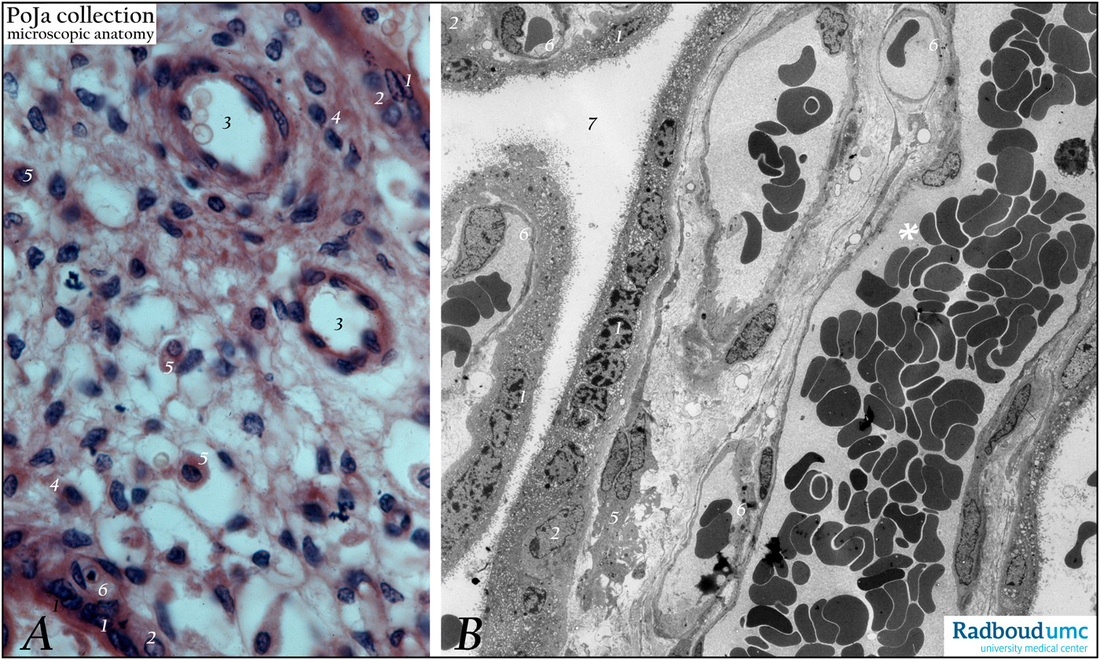7.3 POJA-L1389+1292
Title: Tertiary villi (human placenta, late midpregnancy)
Description: (A) Left: stain: Hematoxylin - azophloxine. (B) Right: electron microscopy (low magnification).
At the left (A) multinucleated syncytiotrophoblast cells (STCs, 1) and vaguely cytotrophoblast cells (CTCs, 2) cover the loose fetal stroma (4). A large and a small arteriole (3) are embedded with stroma. Free cells such as fibroblasts and Hofbauer cells (5) (fetal phagocytes) are present. On ageing, dilated capillaries (6) tend to get localised near the basal membrane of the placental barrier (so-called vasculosyncytial membranes).
At the right (B) a low magnification of a few terminal (tertiary) villi is shown: these villi are lined by STCs (1) that contain several distinct nuclei. A single CTC (2) is still present. Several capillaries are located close to the basal lamina of the placental barrier (6) forming the so-called vasculosyncytial membranes. At asterisk a large venule filled with erythrocytes. (5) points to a free fetal phagocyte (Hofbauer cell). (7) indicates intervillous space.
Background: The placental barrier is formed on the one hand by the CTCs, STCs and a supporting basal lamina and on the other hand by the endothelial cells and basal laminae of the fetal blood capillaries. This barrier separates fetal vessels from the circulating maternal blood in the intervillous space, regulates as a membrane the transport of gases, hormones and nutrients in both directions. Embryonic/fetal waste products also pass from embryonal/fetal blood to maternal blood as well. Especially the trophoblastic layers (CTCs and STCs) play an important role in these processes. The barrier partially prevents penetration of foreign material as bacteria, toxins e.a. from maternal blood to fetal blood. However some maternal antigens and numerous viruses (e.g. HIV virus, rubella virus) as well as various drugs are still able to cross this barrier.
Keywords/Mesh: placenta, tertiary villi, placental barrier, Hofbauer cell, vasculosyncytial membrane, syncytiotrophoblast, chorionic villi, trophoblast, histology, POJA collection.
Title: Tertiary villi (human placenta, late midpregnancy)
Description: (A) Left: stain: Hematoxylin - azophloxine. (B) Right: electron microscopy (low magnification).
At the left (A) multinucleated syncytiotrophoblast cells (STCs, 1) and vaguely cytotrophoblast cells (CTCs, 2) cover the loose fetal stroma (4). A large and a small arteriole (3) are embedded with stroma. Free cells such as fibroblasts and Hofbauer cells (5) (fetal phagocytes) are present. On ageing, dilated capillaries (6) tend to get localised near the basal membrane of the placental barrier (so-called vasculosyncytial membranes).
At the right (B) a low magnification of a few terminal (tertiary) villi is shown: these villi are lined by STCs (1) that contain several distinct nuclei. A single CTC (2) is still present. Several capillaries are located close to the basal lamina of the placental barrier (6) forming the so-called vasculosyncytial membranes. At asterisk a large venule filled with erythrocytes. (5) points to a free fetal phagocyte (Hofbauer cell). (7) indicates intervillous space.
Background: The placental barrier is formed on the one hand by the CTCs, STCs and a supporting basal lamina and on the other hand by the endothelial cells and basal laminae of the fetal blood capillaries. This barrier separates fetal vessels from the circulating maternal blood in the intervillous space, regulates as a membrane the transport of gases, hormones and nutrients in both directions. Embryonic/fetal waste products also pass from embryonal/fetal blood to maternal blood as well. Especially the trophoblastic layers (CTCs and STCs) play an important role in these processes. The barrier partially prevents penetration of foreign material as bacteria, toxins e.a. from maternal blood to fetal blood. However some maternal antigens and numerous viruses (e.g. HIV virus, rubella virus) as well as various drugs are still able to cross this barrier.
Keywords/Mesh: placenta, tertiary villi, placental barrier, Hofbauer cell, vasculosyncytial membrane, syncytiotrophoblast, chorionic villi, trophoblast, histology, POJA collection.

